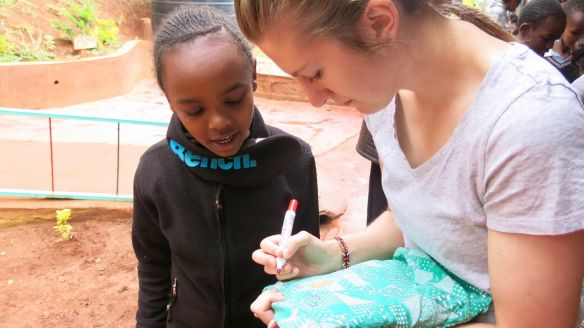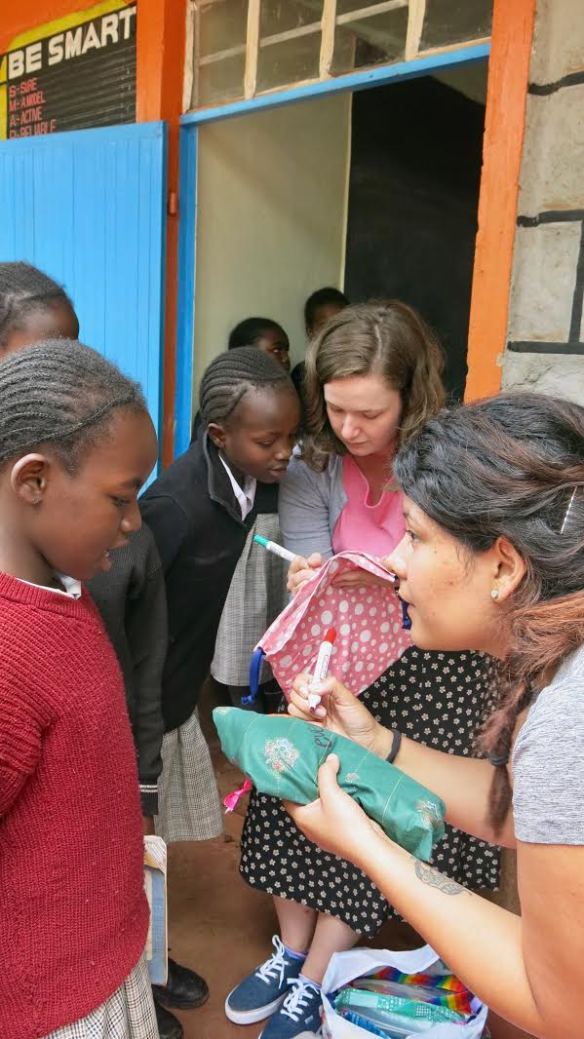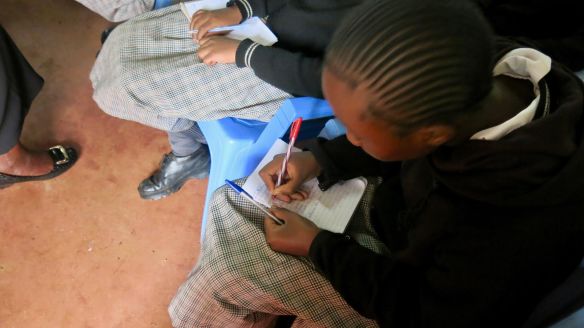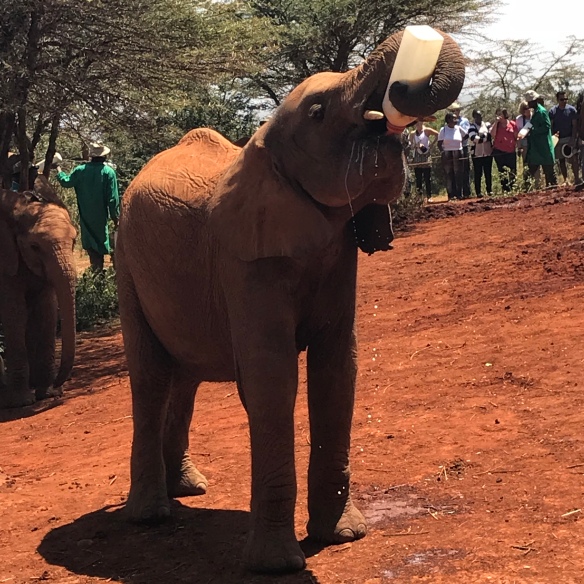
Our 2018 blog is now available!



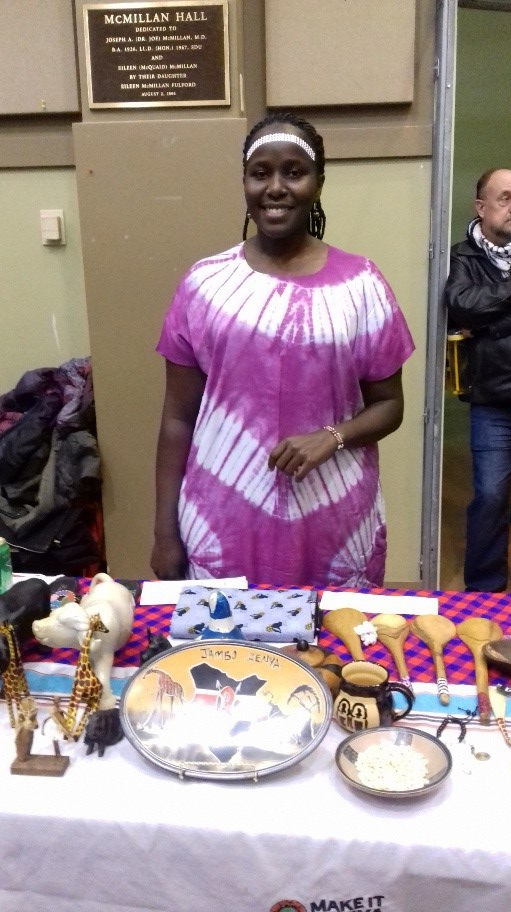
Sarah posing with some of Kenya’s essential artifacts
By Anne Shileche, Queen Elizabeth II Diamond Jubilee Scholar
Jambo is the most famous greeting phrase used in Kenya. I want to believe that Kenya is somehow well known by people over the world, partly because of our excellent track record in long distance running. Nonetheless, I never miss the opportunity to talk about Kenya and its global positioning – it is one of the best known countries on the African continent.
The University of Prince Edward Island (UPEI) prides itself on having a multi-cultural student community. UPEI is always seeking ways to support its students, especially the international students, to live and integrate into the Canadian culture. Among the numerous activities assisting students to enjoy their studies and time on campus, one favorite event is the Global Village. The global village is a fun-filled afternoon and evening that gives international students an opportunity to showcase their culture. The Kenyan team thought of the Global Village event as an excellent place to share the vibe of their land with students from Prince Edward Island and the rest of the world.
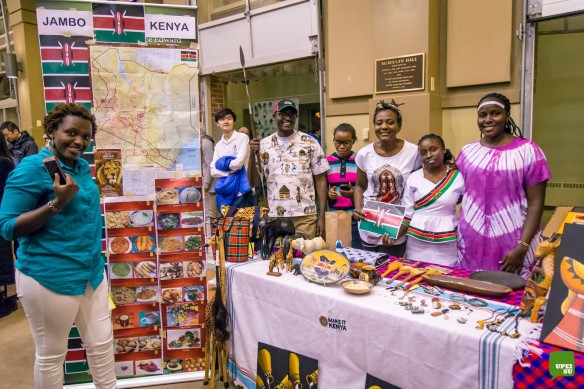 Kenyan team; from right, Peter, Dorcas, Anne, Grace and Sarah. Emily standing next to poster Credit: UPEI Student Union photographer Pravakar Thapa
Kenyan team; from right, Peter, Dorcas, Anne, Grace and Sarah. Emily standing next to poster Credit: UPEI Student Union photographer Pravakar Thapa
It took the team a few weeks of planning for the event. As all Kenyans who participated in the event are graduate students, time was in short supply, and it took a lot of commitment to hold group meetings. We supplemented our physical sessions with the use of WhatsApp. Communication through the online group made things easier and faster, progress was tracked and problems solved by instant feedback. Tasks were distributed among members. The team settled on showcasing the Kenyan culture in the following themes: (1) National identity featuring the flag, emblems of the spear and Swahili language; (2) tourism featuring the big five animals; (3) indigenous tribes; (4) traditional foods; (5) art featuring bracelets and paintings; and (6) dressing style.
We also reached out to several members of the UPEI Queen Elizabeth II Diamond Jubilee Scholarship Program led by John VanLeeuwen, and Farmers Helping Farmers, a nonprofit organization working in Kenya, who had been to Kenya and had some souvenirs.
Team members took turns to explain to visitors at the booth about Kenya in general and about the exhibits in specific. Guests were curious and asked questions about the wild animals; the taste of white corn, what we call maize; and why our flag had four colors.
As we explained and answered questions, we could read excitement and amazement on the visitors’ faces, while others would express this loudly. I remember one person double checking that there were no winters in Kenya. Another wanted to know how he could volunteer for a wild animal conservancy.
It was a proudly engaging moment for all members of the team. Having this opportunity to talk about things that identify the nation of Kenya and its people made us feel at home.
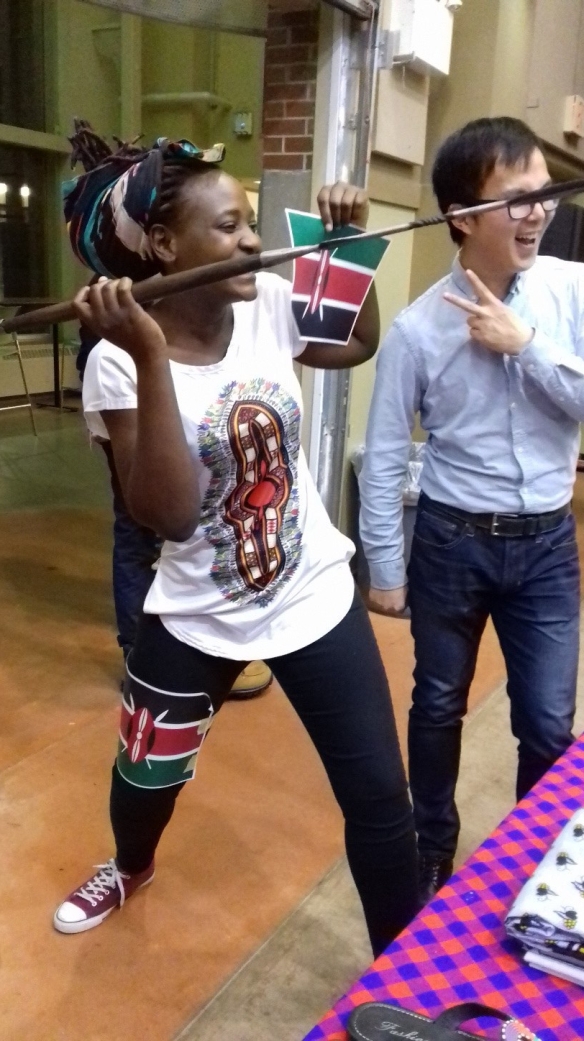
Anne demonstrating how to use the traditional spear
Before the end of the evening, I got a chance to visit several booths and learn about other world cultures. I went over to the Saudi Arabia station and observed their sparkling white robes with attractive head gears, tasted their sweet dates and strong Arabic coffee, and got a writing of my name in the Arabic language. At the Bahamas booth, I learned that this island nations is made up of a combination of over 700 small islands, each unique in its own way. One Bahamian talked about an island known for its pink sandy beaches. My attention was captured, and the Bahamas is added to my bucket list. Aside from the booths, there were electrifying presentations on the stage from countries including China, Spain, Iran, Rwanda, and Japan. The Global Village was a happy and fulfilling event for me. I look forward to taking part in it again during 2018 winter semester.
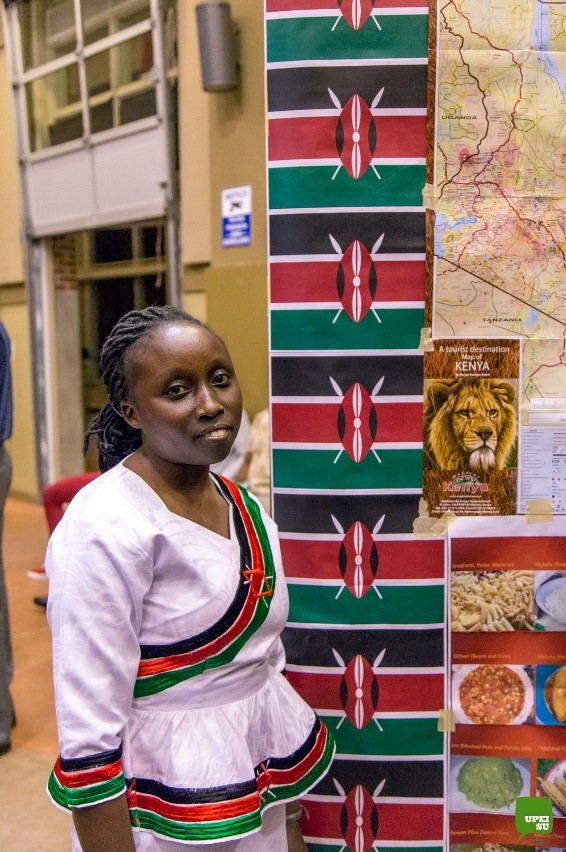
Grace showcasing her dress bearing the Kenyan flag Credit: UPEI Student Union photographer Pravakar Thapaf
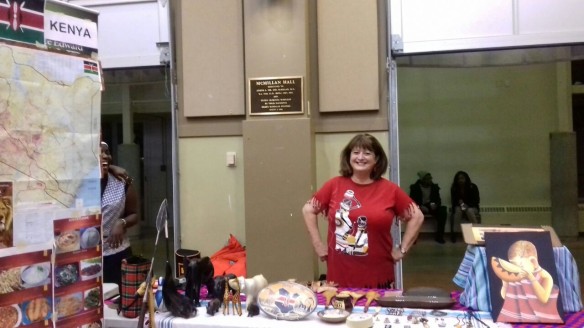 Jennifer Taylor (UPEI professor) came out to support Kenyans
Jennifer Taylor (UPEI professor) came out to support Kenyans
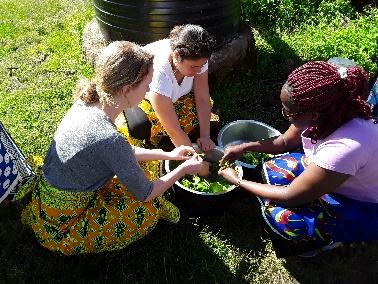
My name is Sarah Muthee. I am a second year graduate student at UPEI pursuing a Master’s degree in Human Nutrition, specializing in Food Security.
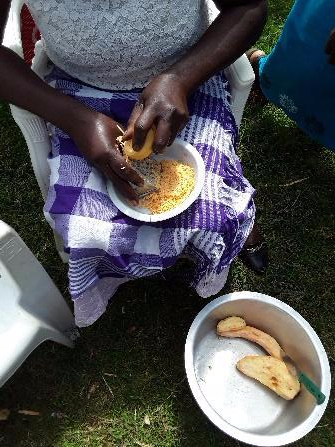
Research has shown that nutrition education plays an integral role in improving the food security and the nutritional status of women particularly when integrated with other agricultural interventions. This approach has been adapted in many developing countries such as Bangladesh and has produced profound results in improving both the quality and quantity of diets, most especially in the poor resource settings where women are limited by both cultural and financial constraints.
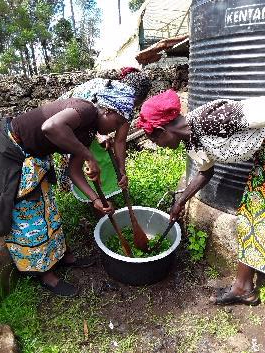
Although a lot of literature exists on food insecurity in Kenya, there is limited knowledge about the impact of a combined agriculture and peer-led nutrition education intervention in alleviating food insecurity. Therefore, my research projects seeks to investigate how this combined approach impacts the food security, diet diversity and nutritional knowledge, attitudes, and practices of rural women farmers, belonging to self-help groups in Naari, Meru County.
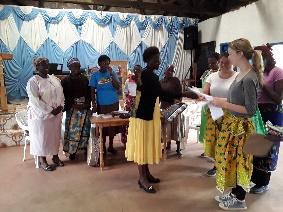
Below are few photos of the enhanced gardens: The magical gardens that are providing fresh and nutritious vegetables to women all year round.
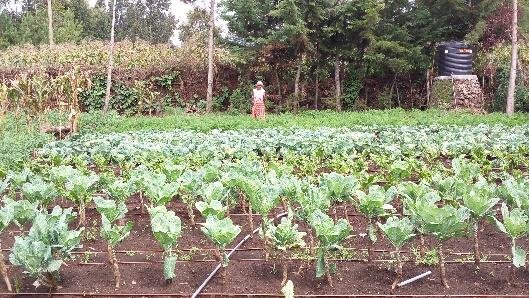
Below are few photos of the champions being trained and the cooking sessions:
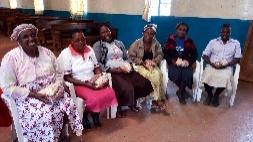
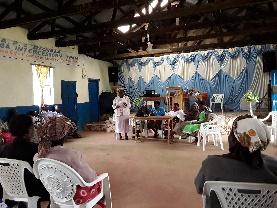
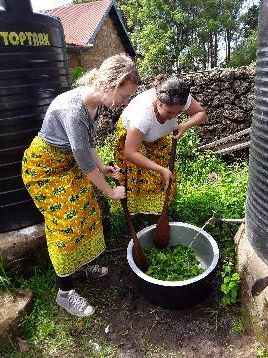
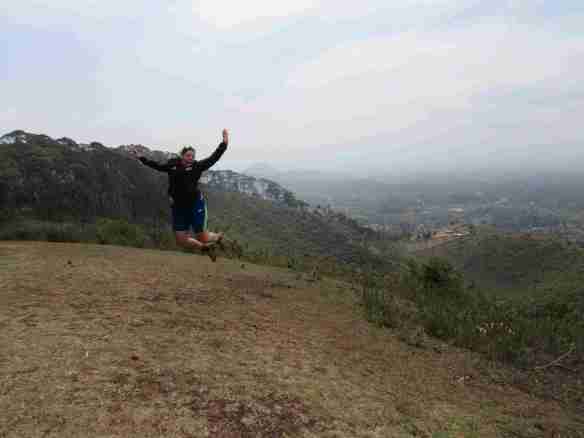 by Ren Chamberlain
by Ren Chamberlain
Readers,
Please enjoy a few small stories from my time here in Kenya!
Jul 15: Today we finally hiked the ever present looming mountain of Mei Tei. In this case the word looming is to indicate a mountain that is simply much taller than any in PEI. The 40 min or so trek of a steep face was worth the sweat and tears. Reaching the summit presented us with a flat surface with trees spaced out in a perfect arrangement. A trail led us even further to reach the open face on the top of Mei Tei, rewarding us with the view of the summer! Meru town off to the left in the distance and our little Naari village directly in front of us but at quite a distance below. After some time playing “Where’s Waldo?”, we even spotted our house and Muruguma Primary School across the street!!!
Jul 9: The American soldiers (friends we made at the Samburu Safari) have started a project to build a new orphanage for Mama Wachiras. The current place hosts about 50 kids with 7 kids to a room. They bought sheep, goats and chickens for the place, and we have offered to go and deworm the sheep/goats. We were able to deworm around 50 of their animals and boy it was a lively event. One by one, each animal was wrangled, then released from the little shed and caught in mid-leap by one of the Kenyan boys. Then Julia and I would rotate between filling our syringe and prying their little jaws in order to dose them with Twigazole dewormer! It was intense, amusing, and all around fulfilling.
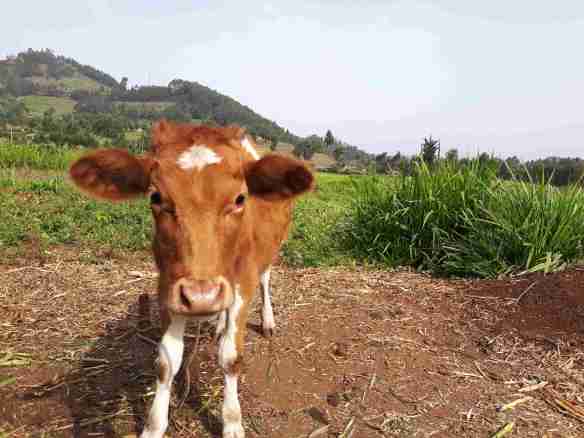
Photo of a young bovine “The best patients are cows”
June 29: I am currently in Mukurwe-ini visiting the Vets Without Borders project. We went to a school today that seemed like a Kenyan version of a Dr. Seuss learning center! The place had stone paths to each classroom lined by brightly coloured rocks and motivational sayings amongst the shrubs and flowers. While trying to take in all of the magic, you would get distracted by the children launching themselves from the classroom to sprint to their next class! The first antelope child took me by surprise but eventually the lines of jogging school children became very enjoyable to see while also making me realize that this rule would never be put in place at a school back home. What a great way to keep students awake throughout the day, it certainly provides them with constant periodic exercise!
We have a very short time remaining here in Kenya. See you soon Maritimes!
Ren Chamberlain
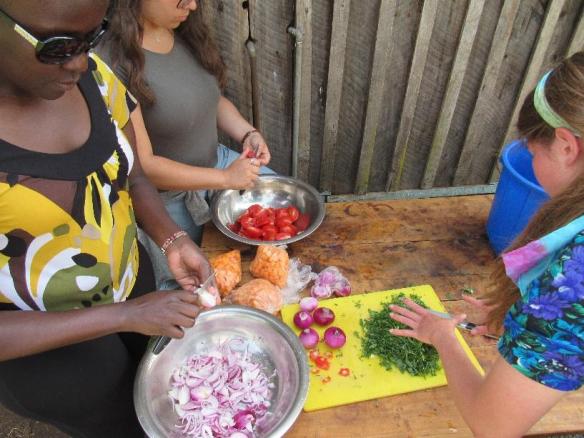
Sarah Muthee, Mireyne MacMillan (from the nutrition team) and Julia Kenny (visiting from the vet team!) chopping vegetables for “super githeri”. Sarah visited schools in the summer of 2016, so she was a great support as we learned how to do the school meal assessments.
by Michaela Rowan and Grace Wanjohi
Now that we’ve been in Naari, Kenya for over two months, we want to tell you about the nutrition team’s work with 9 schools in our area.
We visit every school twice within a two week period. During the first visit, the first stop is usually at the office of the head teacher or principal of the school. Here, we request permission to assess the school meals. We also explain how the meals will be assessed for their nutrient content. Finally, we agree on a date for a second visit to report on our assessment and conduct a parent’s seminar, which is a session of teaching nutrition messages to the parents.
The next stop is the cookhouse, or kitchen, where meals are prepared for the children. These meals include uji (maize porridge), which is often served to the nursery children only, and githeri (a stew made with maize, beans and sometimes vegetables) which is served for lunch to all students. After we see how the meals are being made, which ingredients are being used and what amounts are used, and measure the serving sizes the children are getting, our team will evaluate the nutritional content of the mal and compare it to nutrient requirements for the male and female students in the various age groups and write a report to give back to the school.
During our second visit to the school, we go over the feedback in the report with the head teacher and administration of the school. We discuss recommendations to improve their school meals, such as soaking the maize and beans, using whole grain maize and using a 1:1 ratio for the maize and beans in the githeri. We have not analyzed all the data yet, but we notice that the schools which have their own gardens and have been using drip irrigation really show a difference in the nutritional value of the lunches. With the gardens and drips, the schools are able to provide green and orange vegetables (like kale, carrots and orange sweet potatoes) more often, which provides nutrients like β-carotene (the plant form of vitamin A) and vitamin C that are otherwise missing from the children’s diets. Supplying a good source of these nutrients is very important since both are very important in growth and in helping children to resist infection.
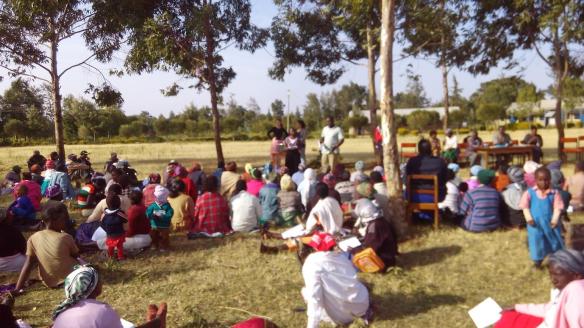 We also take the opportunity to talk to the parents of the school children. This year, for the first time, we held nutrition education seminars for the parents after we meet with the head teacher and administration. We discuss several nutritional messages in a seminar while providing a food sample of “super” githeri with whole grain (mpempe) maize, extra beans for protein, one orange and one green vegetable and more vegetables overall. The food is very popular and shows them that preparing githeri the nutritious way tastes delicious..
We also take the opportunity to talk to the parents of the school children. This year, for the first time, we held nutrition education seminars for the parents after we meet with the head teacher and administration. We discuss several nutritional messages in a seminar while providing a food sample of “super” githeri with whole grain (mpempe) maize, extra beans for protein, one orange and one green vegetable and more vegetables overall. The food is very popular and shows them that preparing githeri the nutritious way tastes delicious..
Sample portion of super githeri prepared for parents in Michogomone Secondary School. This one has carrots- we are hoping to see more vitamin A rich orange fleshed sweet potatoes as an increased number of schools are growing them.
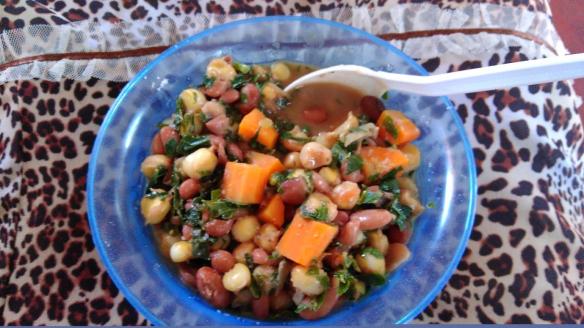
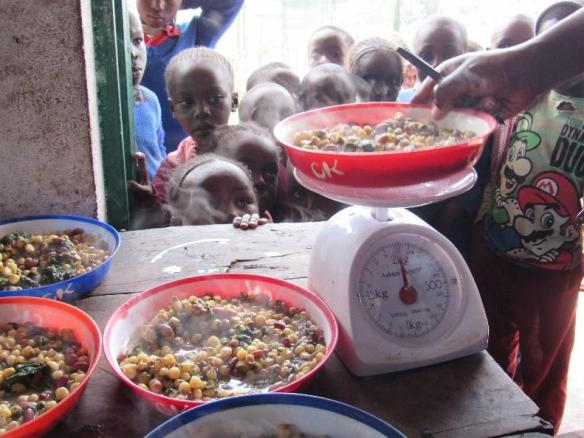 Measuring the typical serving of githeri: we do this so that we can estimate the amount of nutrients in a typical child’s serving.
Measuring the typical serving of githeri: we do this so that we can estimate the amount of nutrients in a typical child’s serving.
The nutrition education seminars with the parents have been a very positive experience. When discussing the nutritional messages with the parents, I can see their eagerness to learn on their faces. Usually, after each message, we get plenty of questions regarding what we are discussing and typical Kenyan cooking methods which can make for a good discussion. I always look forward to the school seminars. I think it is an effective way to talk to the parents/community about important nutrition messages since we can reach over 100 parents at one time! The attendance is amazing and it shows their interest in being educated about feeding their children. Also, since the parents provide most of the foods for the schools, it is great being able to meet and discuss directly with them the best methods and foods to provide for optimal nutrition for their children.
 During a seminar with the parents with Stephen Mwenda from Farmers Helping Farmers. Note the huge pot of ‘super githeri’ for sampling!
During a seminar with the parents with Stephen Mwenda from Farmers Helping Farmers. Note the huge pot of ‘super githeri’ for sampling!
Unfortunately, some of the schools we have visited have been having difficulty providing maize and beans to the children. There have not been enough rains this season, so there have not been good harvests. This also increases the price of maize and beans if they are available for purchase (this year there is a national maize shortage). Parents provide these foods to the school for their children, and in the case of some schools, they have run out of beans and are only serving maize to the children. Some will soon run out of maize. The schools that have gardens, water tanks and drip irrigation provided through Farmers Helping Farmers can provide green and orange vegetables which improve the school lunches nutritionally, but the maize and beans are still an issue when there aren’t enough rains. This is so important since beans are the main source of protein for the growing children and their families and this may be their only meal of the day. While Colleen Walton from Farmers Helping Farmers was here, she was able to alert local government officials about the food shortages; we hope that the schools in Naari will be able to get enough food to last until the next harvest.
It has been amazing to see the new school cookhouses from Farmers Helping Farmers sponsored by the Souris Village Feast. The schools which currently have traditional cookhouses are almost unbearable to remain inside while the food is cooking due to the amount of smoke. At one school, I (Michaela) tried to stay in for several minutes to help cook the githeri but my eyes were watering and it was difficult to breathe! The cook stayed inside the whole time without any complaints, but we know that the smoke is bad for their health, and the cookhouses require a lot of wood for fuel compared to the new cookhouses which have energy efficient stoves.
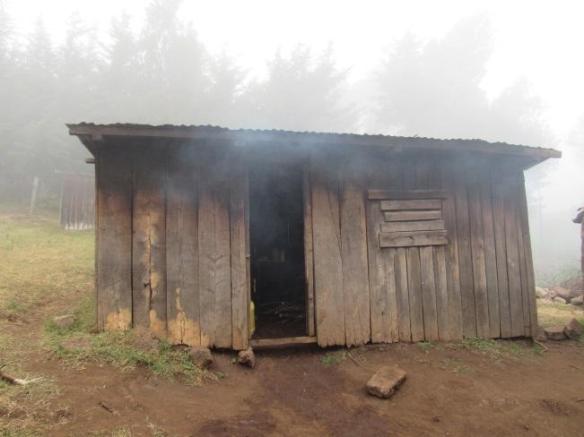
A typical school cookhouse.
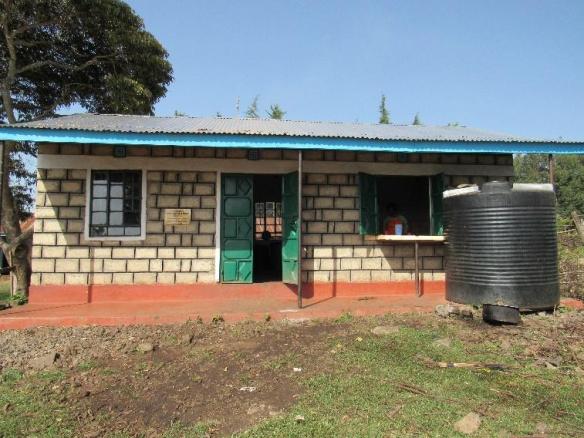 Michaka Primary School’s beautiful new cookhouse sponsored by the Souris Village Feast.
Michaka Primary School’s beautiful new cookhouse sponsored by the Souris Village Feast.
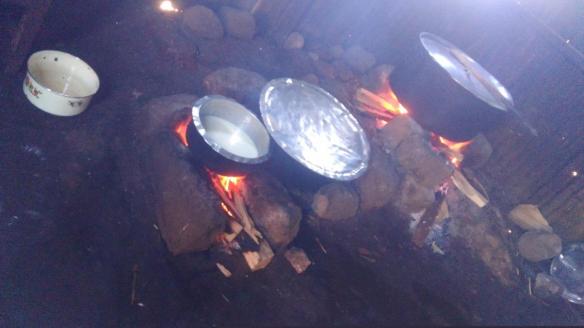
Lunch cooking in one of the traditional cookhouses
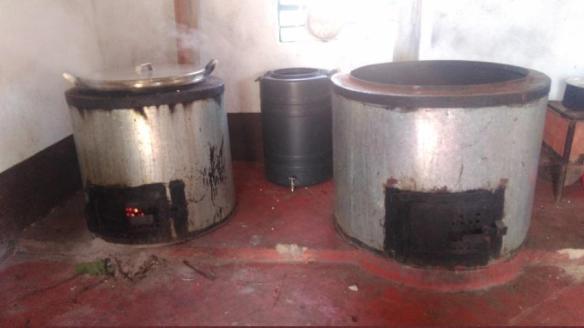
Lunch cooking in the large modern cookers in the cookhouses built by FHF and the Village Feast
The warm reception of the kitchen staff and the fact that they work in these conditions day in, day out makes us appreciate and really commend these heroic women and men for their great service to the Kenyan students. This year, there are four newly twinned schools with FHF, and after seeing the work that has already been done, it is a great feeling knowing that more schools will benefit from working with Farmers Helping Farmers and the generosity of the Souris Village Feast. I understand the Village Feast is coming up soon (Sunday July 16) http://www.villagefeast.ca/. I know now just how important it is to support this event so that more schools will have cookhouses!
All in all, we’ve really enjoyed visiting the schools! The teachers and staff are welcoming each time and the children have amazing energy and are always excited to have visitors. During the days that we assess the school meals, there is usually some time during break to play with the children. This is one of my favorite parts since the children are full of excitement and have lots of ideas for games. One of the things we enjoy doing is to sing songs we are familiar with and learn some of their familiar Kenyan songs (and dances). Working with the schools in Naari has truly been a very rewarding experience.
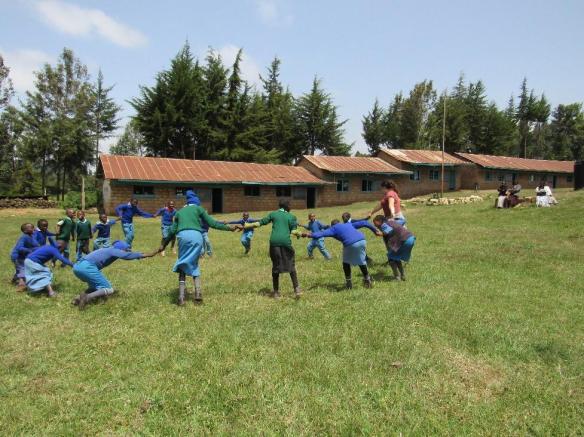 Mireyne playing a game with the children
Mireyne playing a game with the children

Doing the ‘Mwanambere’ dance with Upendo women group
by Anne Shileche
I have spent the last one month traversing the Naari community in Meru. This place is both cold and hot; it depends on which location one stands. It is also rocky, and when we are in the car, mostly we are vibrating because of the rough and rugged terrain. I have learned some key Meru words to help with communication. But even with my efforts in pronunciation, my accent still sells me out. Nonetheless, I am awed at the warm hearts of the people in this community, they have been kind to let me into their homes and their lives. Some women have nick named me ‘Mwanamberi’ after I did a dance gig of the popular West Kenya song by the same name.
The majority of people in Naari are small-scale farmers, they keep dairy cows for milk and grow crops like maize, beans, Irish potatoes, and vegetables. The community has a dairy cooperative society which gives farmers a place to sell their milk. Naari Dairy Cooperative Society collaborates with partners like Farmers Helping Farmers and Queen Elizabeth Scholars to assist members with their farming ventures. Training in areas of agriculture, cattle management, and human nutrition is being offered to many farmers in the area. My movement within the community is to do with visiting selected farmers at the dairy, and finding out their perceptions on this training, how they are using it, and what is challenging or working for them.

In this picture, I am administering a survey to a woman who has received training on how to prepare and cook nutritious food. Survey questions range from demographic information, group organization and structure, self-confidence and community engagement. I am using a tool called Growth Empowerment Measure to help measure women’s emotional empowerment. The GEM tool was developed by Australian researchers led by Melissa Haswell. I am excited to pilot the GEM tool in Kenya.
My whereabouts in the community would be incomplete without taking the time to enjoy and appreciate some things like the sun, the food, and the smiles.
It took me experiencing a winter in Canada to appreciate the sun in Kenya. I am always happy to bask in it. I also enjoy the ripe avocados falling off Naari trees; this place is magical.

Lastly, my time in the field can never happen without Mary, my translator and Paul my driver, they tell me village stories which are hilarious. They have become my mama and papa.

Kenya 2017 Blog 6
by Julia
The time continues to pass swiftly here in the quiet town of Naari, Kenya. We have completed yet another week of farm visits and have begun working on the second half of our project which entails implementing the recommendations that we have made at each individual farm. Throughout the past month and a half, we have made several visits to each farm involved in the project and, consequently, have had the privilege of becoming good friends with many of the farmers. There is one lady in particular, Deborah, who has been exceedingly kind to us. She always greets us with a bright and beautiful smile and a laugh. When we have finished our work, she stops whatever she has been doing and sits with us on the grass in the warm sunshine after ensuring that each of us has a steaming hot cup of Cadbury drinking chocolate. We usually spend fifteen or twenty minutes chatting with her until our chocolate is gone. Last time we visited Deborah, she invited us to come to dinner one night whenever we were free. The night that we were free was this past Tuesday.
We arrived for dinner around 6:30 in the evening. There was quite a large group of us that had decided to go. There was the vet team which included Emily, Joan, Ren and I, along with the Naari Dairy vet technician, Bernard as well as Sarah, our nutrition masters student and Kithenji, our driver here in Naari. We were greeted with a warm welcome and shown into the living room. It was a spacious room with pale pink walls and two beige couches that were heavily adorned with lace covers. The coffee tables had glass tops and displayed a varied assortment of vividly colored fake flowers. The light from the chandelier burned brightly but with a dark yellow hue which lent a cozy and homelike atmosphere to the room. We all took our seats on the couches and Deborah began to bring in one steaming pot after another filled to the brim with the delicious feast that was to be our dinner.
How should I describe the dinner we ate that night? Incredibly delicious? Unbelievably scrumptious? I think the simplest of terms might describe the meal better. Let me say that the feast that Deborah served us was good in the fullest and most profound sense of the word. The dinner included chicken stew, mukimo (a local dish of mashed potatoes mixed with corn, beans and stinging nettles), chicken legs and wings, flavored rice, and chapattis, followed by watermelon with chai, coffee and hot chocolate for dessert. We were so full afterwards that we were unable to get off of the couch for a while. However, that did not stop us from having a good time. We exchanged stories and jokes for the next hour or two. Sometimes we were laughing so much that breathing became a significant challenge. This was only the beginning of the fun. Ren and I gave a live performance of the “Cup Song” and the others joined us in singing to other songs that we all knew. We finished off the evening by dancing to some African themed songs that were playing on the radio.
It was then approaching 10:00pm and we sadly realized that it was time to go home. We helped our hostess clear the table and clean the dishes before thanking her for a lovely evening and delicious dinner and taking our leave. As we were driving home down the bumpy, dusty roads of Naari, I could not help but reflect once again on the kindness of the people here and the wonderful memories I now possess which I owe to them. I continue to look forward to the weeks to come and anticipate many more good times and new adventures.
Mambo Rafiki!
With the start of the fourth week, the entirety of the summer crew in the house together and enough Kimeru (local mothertongue) to get by….things are settling in. For any keen readers, let me introduce myself. Mimi ni Ren (I am Ren), a 3rd year student at AVC and the house busker. I brought the essentials to Kenya; my guitar, my poi (glowing spinning balls) and my SPF 60. That being said, it seems as though it is too late to stop my very noticeable farmer’s tan.
Although a day by day playback would indeed be exciting to read, I will stick to some of the highlights. Highlight number one: Samburu Safari. Enough said with the smile on our faces in this video blog! (https://youtu.be/fWg74esV7ok)
Next, I invite you to see it and believe it. (https://youtu.be/cB0FXAvCQbU) Our day spent with the nutrition team brought us across the street from our house to Muruguma Primary School where we spent our time observing the cooking process and then spoke to each class, exchanging answers to shyly asked questions about Canada for a sneak peek into their school lesson that day. The most memorable moment was when a small but uber confident girl, Sharon, stood up and marched to the board to lead her equally small classmates in a call and answer for the numbers 1-10. ONE. One. TWO. Two…and so on.
While we are talking about learning and language, I would be remiss to not mention my developing Kimeru (the mother tongue in Naari). It is amazing what the smallest amount of effort can do. Merely saying “muuga” (how are you) gets me responses of laughter, clapping and mainly gigantic smiles. This works to make me even more keen to continue expanding my Kimeru and Swahili vocabulary. A vicious cycle in the best way.
Nibwega, asante sana and squashed banana.
Ren Chamberlain
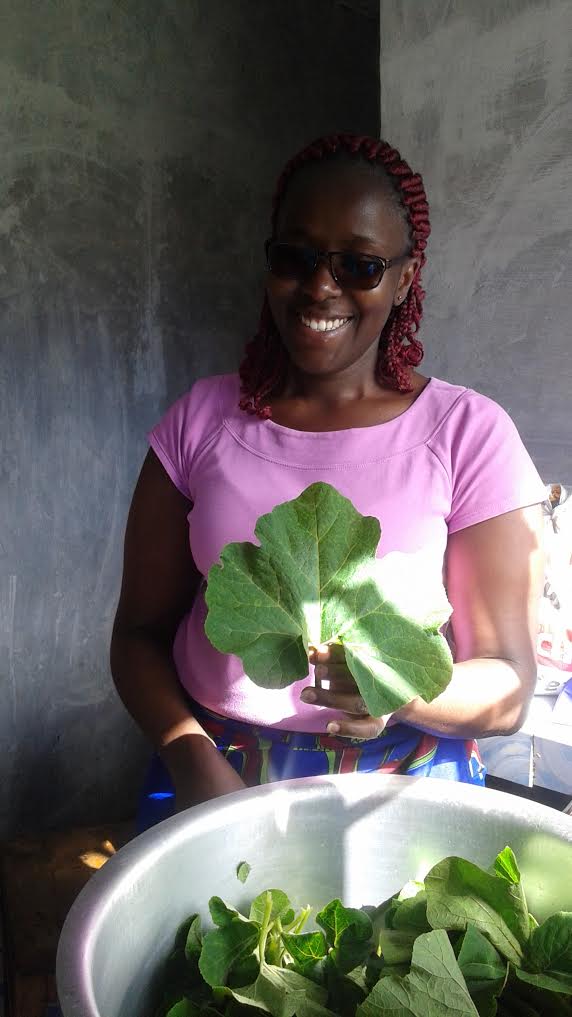
Enhanced kitchen gardens are improving the diet diversity of women and families in Naari
by Sarah Muthee
Communities in Kenya are faced with different challenges. However, food insecurity and nutrition deficiencies have, over the years, been the most common problems affecting women and children in rural areas. Food insecurity exists when an individual or family lack access to sufficient quantities of safe and nutritious foods to be healthy and achieve their full potential. A lack of dietary variety, which is also common in the Naari area where we are working, often results in inadequate intakes of essential nutrients like iron, vitamin A, and zinc by women and children putting them at risk of poor health.
From left: Mixed beans, Mpempe (whole maize) maize and Muthikore (polished maize)
Kenya, like many other developing countries, has made slow progress in mitigating the effects of global warming, water scarcity and poverty, which are significant contributors to food insecurity and a lack of dietary diversity. Currently, the country is experiencing extreme climatic conditions. The prolonged dry spell has resulted in crop failures and escalating food prices especially that of Mpempe maize/corn which is the main staple. In particular, Naari area has received very little rain this spring, with similar trends in many parts of the country.
Ugali the main staple in Kenya (made from Mpempe maize/corn)
Farmers Helping Farmers (FHF), a non-governmental organization based in Prince Edward Island, has recognised the need to improve food security and has in the past thirty years partnered with different Women Self-help Groups in rural Kenya in order to improve their livelihoods. Currently, the organization is working with the Joy and Upendo Women Self-help Group’s in the Naari area in Meru County. The organization has provided water tanks drip pipes, quality vegetable seeds, as well as training on gardening, compost manure preparation, and pest control.
Despite the effects of global warming, water scarcity and high food prices in the country, families in Naari continue to thrive because of the assistance they have received from FHF. More women are now becoming proficient in vegetable and fruit production. This has in a great way empowered women smallholder farmers in this area to improve their families’ diets and overall livelihoods.
Baby……carrots Tomatoes
The provision of the enhanced kitchen gardens by FHF has made it possible for women smallholder farmers to provide a variety of healthy and nutritious vegetables to their families which add important diversity to the local starchy diets, which consist of dried maize and beans (with a higher ratio of maize), ugali (made from maize flour and water), rice and Irish potatoes.
Red Onion Bulb Zucchini
A year after the introduction of drip irrigation to this area, a great deal has certainly changed in the women’s diets and it is clearly reflected by what the women are now planting in their gardens as well in their shambas (farms). There have been three major changes that I have noted over the course of the past year.
A very well kept kitchen garden (from left kale, spinach, cabbage and carrots)
First, more women in the community are now more engaged in the gardening of vegetables and fruits than before. The periodic visits by the FHF horticulturist, Stephen Mwenda, have increased their yields. Most women are now planning on how they can expand their garden sizes to double their production (below are some yummy vegetables and fruits that are doing so well in this area).
Orange Fleshed Sweet Potatoes (OFSP) Pili pili hoho (Capsicum)
Second, the drip irrigation technology provided by FHF has reduced over-dependence on rain fed agricultural production thereby enabling women smallholder farmers to produce a wide range of healthy and nutritious vegetables for their families all year round. The initiation of drip irrigation and horticultural training into this area, has made it possible to introduce a variety of new nutritious drought resistant crops in this area. A good example of this is the orange fleshed sweet potatoes (a good source of Vitamin A).
From left Orange Fleshed Sweet Potatoes (OFSP) a rich source of vitamin A, and OFSP vines
The third change that I have seen in the past weeks as a result of drip irrigation technology is that the women’s diet diversity has increased correspondingly with the greater crop variety in their shambas. I have been assessing food security and dietary diversity among Upendo and Joy Women’s group members and these encounters have been full of surprises. I continue to discover new varieties of nutritious vegetables and fruits in the women’s diets. More families are growing and consuming a wider range of highly nutritious green and orange vegetables and fruits than they did before they had the drip irrigation technology or the enhanced kitchen gardens. Examples of these new crops/dishes are squash, carrots, tomatoes, kale, spinach, pumpkin leaves, and stinging nettle among others.
Pomegranate fruit and tree
Michaela enjoying the shade from an Avocado tree Apples
According to Stephen Mwenda (a horticulturist working for FHF), the combined training in gardening and appropriate food preparation techniques have also made women more aware of the importance of integrated agriculture, as well as the nutritional value of different crops in their gardens. As a result of the acquired agricultural skills and nutritional knowledge, more women are now to attend agricultural field days, agricultural fair, and other agricultural symposiums than in the past. It is during these events that they get sprouted fruit seedlings which they then plant in their farms. This has promoted the consumption of different varieties of fruits and vegetables in this area. Examples of these fruits include guavas, oranges, apples, watermelons, and pomegranates which are now widely grown in this area.
Yummy….oranges a good source of Vitamin C Watermelon
Guava tree Mango tree
This increase in crop diversity in Naari clearly shows what women can grow when they have access to water all year round!

By: Natalia Agon
The highlight of my week was handing out re-usable female hygiene kits to Karaguririo Primary School in Mukerweini District.
Farmers Helping Farmers works with Wakulima Dairy there as well as supporting the twining of Canadian and Kenyan schools.
These amazing kits are made by a women’s group in Guelph, Ontario through the NGO Days for Girls.
The kits contain panties, washcloths and multiple pads and liners that the girls can reuse every month.
This program allows the girls to not miss school or any other activities because of their period.
We gave the students a girl empowerment talk that had an emphasis on hygiene and the value of women, the girls were so attentive and had a ton of amazing questions. Their eyes were bright with excitement when it was finally time to get the bags.
